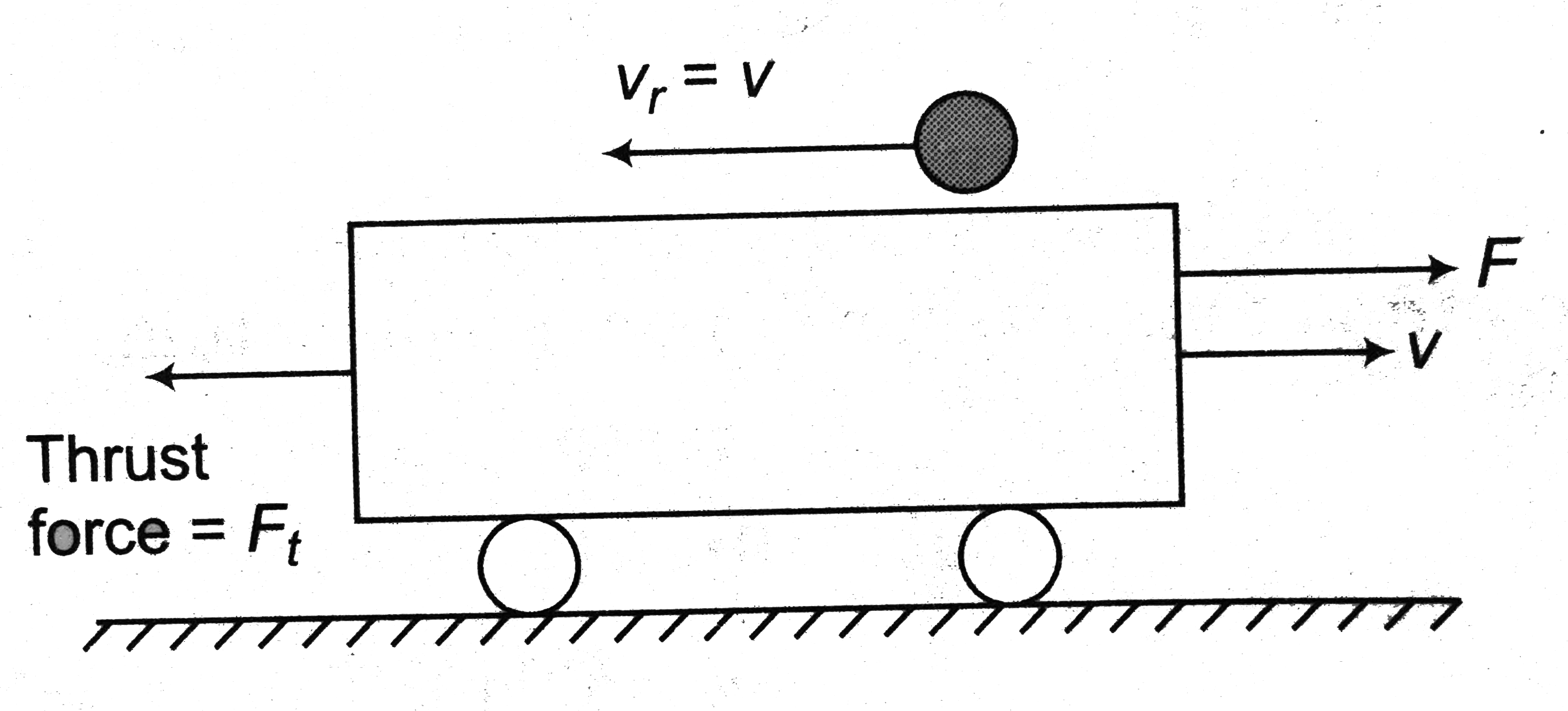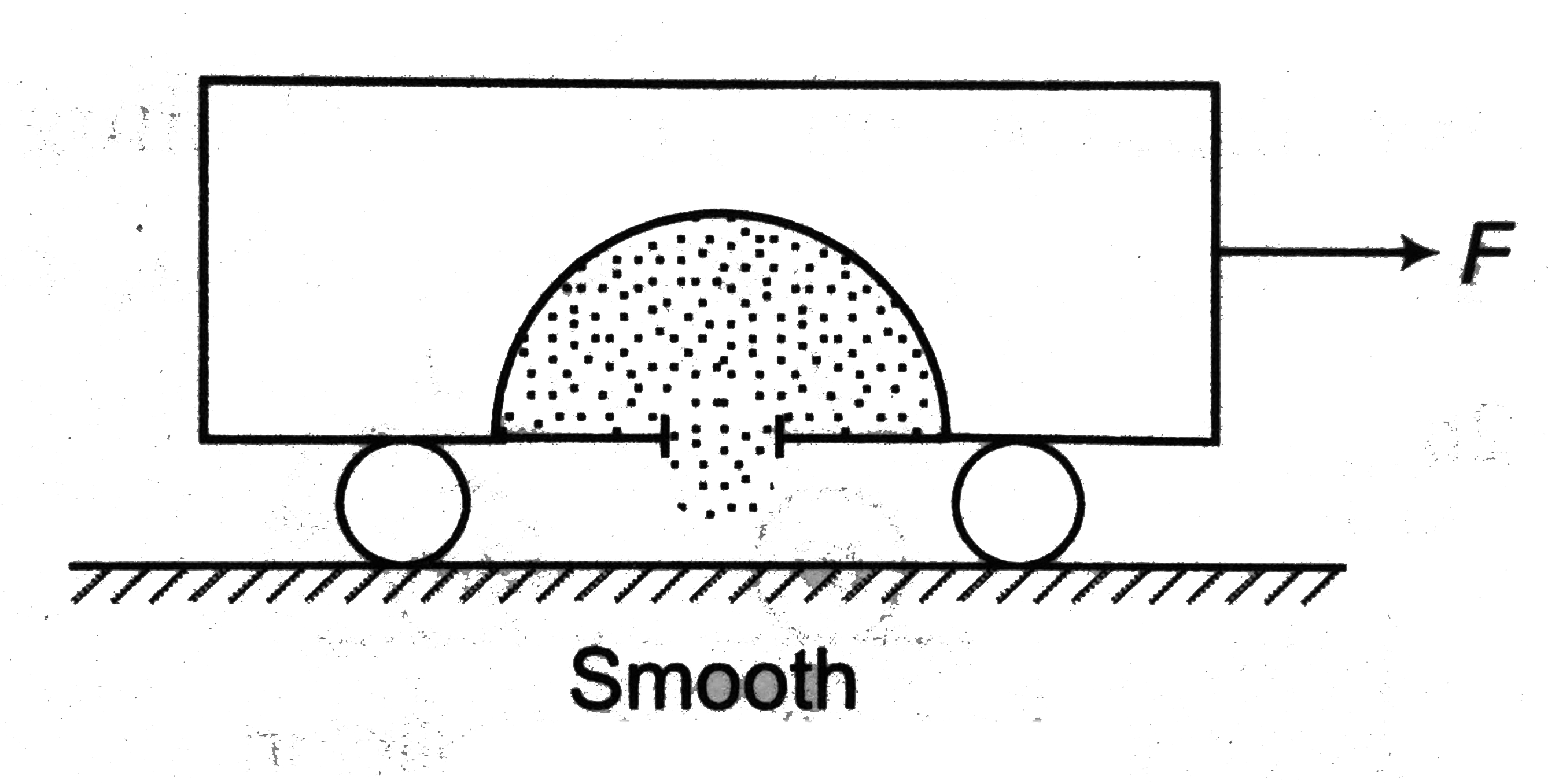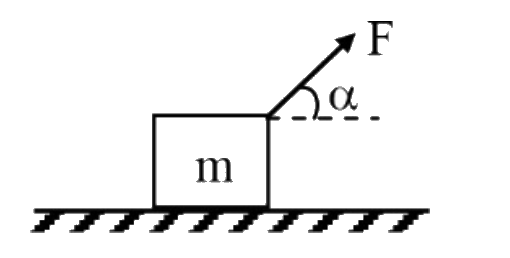A constant force F is applied on a trolley of initial mass m0 kept over a smooth surface. Sand is poured gently over the trolley at a constant rate of (μ)kg//s. Afer time t, find

(a) mass of the trolley (with sand)
(b) net force on the trolley
(c) velocity of trolley
(a) Mass of the trolley after time t is
m=massoftrol≤y+(massofsandpouredpersecond)(time)
=m0+μt
(b) Let v is the velocity of trolley at time t. Sand is poured gently. So, velocity of sand is zero or, relative veloctiy of sand is v in the opposite direction of velocity of trolley. Mass of trolley is increasing. So, thrust force on the trolley is in the direction of relative velocity or in the opposite direction of motion of trolley.

Net force on trolley =F−F1
=F−vrdmdt=F−(v)(μ)
or Fnet=F−μv
In the above expression fo F≠t' velocity v is a function of time which has been asked in the next part.
(c) Fnet=F−vμ
ma=F−μv
⇒(m0+μt)(dvdt)=F−μv
⇒∫v0dvF−μv=∫t0dtm0+μt
Solving this equation we get
v=Ftm0_μt
Topper's Solved these Questions
- CENTRE OF MASS, LINEAR MOMENTUM AND COLLISIONBOOK - DC PANDEY ENGLISHCHAPTER - CENTRE OF MASS, LINEAR MOMENTUM AND COLLISIONEXERCISE - MiscellaneousExamples
9 Videos
- CENTRE OF MASS, LINEAR MOMENTUM AND COLLISIONBOOK - DC PANDEY ENGLISHCHAPTER - CENTRE OF MASS, LINEAR MOMENTUM AND COLLISIONEXERCISE - Exercise 11.1
13 Videos
- CENTRE OF MASS, LINEAR MOMENTUM AND COLLISIONBOOK - DC PANDEY ENGLISHCHAPTER - CENTRE OF MASS, LINEAR MOMENTUM AND COLLISIONEXERCISE - Type 1
1 Videos
- CENTRE OF MASS, IMPULSE AND MOMENTUMBOOK - DC PANDEY ENGLISHCHAPTER - CENTRE OF MASS, IMPULSE AND MOMENTUMEXERCISE - Comprehension type questions
15 Videos
- CIRCULAR MOTIONBOOK - DC PANDEY ENGLISHCHAPTER - CIRCULAR MOTIONEXERCISE - Medical entrances s gallery
19 Videos
Similar Questions
A trolley of initial mass m0 is kept over a smooth surface as shown in figure. A constant force F is applied on it. Sand kept inside the trolley drains out from its floor at a constant rate of (μ)kg/s. After time t find:

(a) total mass of trolley and sand.
(b) net force on the trolley.
(c) velocity of trolley.
View SolutionA constant force (F) is applied on a stationary particle of mass m, the velocity attained by the particle in a certain interval of time will be proportional to
View SolutionA constant force(F) is applied on a stationary particle of mass 'm'. the velocity attained by the particle in a certain interval of time will be proportional to
View SolutionA block of mass 10 kg is kept over a rough surface and a force F=4t is applied on it. At what value of t the block will start moving :-
View SolutionA cart loaded with sand moves along a horizontal floor due to a constant force F coinciding in direction with cart's velocity vector. In the process, the sand spills through a hole in the bottom with a constant rate μkg/s. Find the acceleration and velocity of the cart at the moment t, if at the initial moment t=0 the cart with loaded sand had mass m0 and its velocity was equal to zero. Friction is to be neglected.
View SolutionAt the instant t=0, a force F=kt (k is a constant) acts on a small body of mass m resting on a smooth horizontal surface. The time, when the body leaves the surface is

View SolutionA trolley filled with sand is moving with a velocity v on a smooth horizontal surface due to inertia. If the sand falls off at the rate of μkg/sec, the velocity of the trolley as a function of time will be best represented by:
View SolutionA man of mass 60kg jumps from a trolley of mass 20kg standing on smooth surface with absolute velocity 3m/s. Find velocity of trolley and total energy produced by man.
View SolutionA trolley of mass M is at rest over a smooth horizontal surface as shown in figure. Two boys each of mass 'm' are standing over the trolley. They jump from the trolley (towards right) with relative velocity vr [relative to velocity of trolley just after jumping]
(a) together
(b) one after the other.
Find velocity of trolley in both cases.

View SolutionTwo trolleys A and B are free to move on a level frictionless track, and are initially stationary. A man on trolley A throws a bag of mass 10kg with a horizontal velocity of 4ms−1 with respect to himself on to trolley B of mass 100kg. The combined mass of trolley A (excluding bag) and the man is 140km. Find the ratio of velocities of trolleys A and B, just after the bag lands on trolley B.
View Solution
